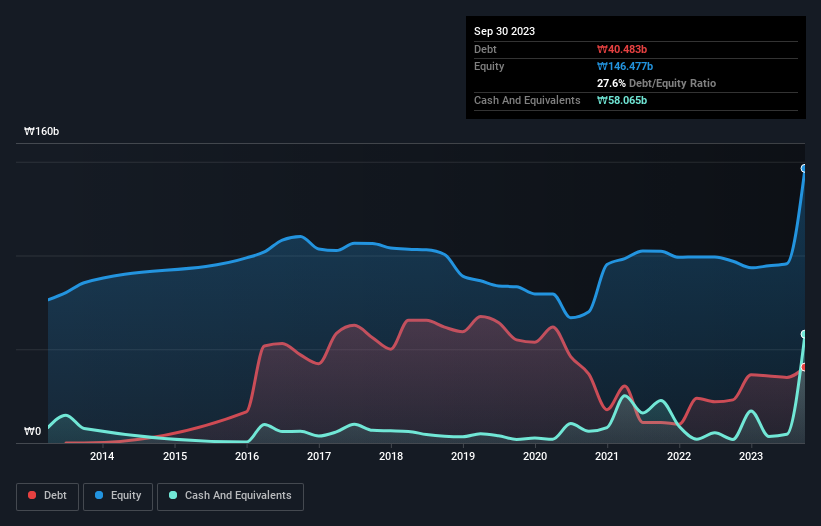- South Korea
- /
- Leisure
- /
- KOSDAQ:A024950
Samchuly Bicycle (KOSDAQ:024950) Has Debt But No Earnings; Should You Worry?
Warren Buffett famously said, 'Volatility is far from synonymous with risk.' It's only natural to consider a company's balance sheet when you examine how risky it is, since debt is often involved when a business collapses. As with many other companies Samchuly Bicycle Co., Ltd (KOSDAQ:024950) makes use of debt. But the more important question is: how much risk is that debt creating?
Why Does Debt Bring Risk?
Debt is a tool to help businesses grow, but if a business is incapable of paying off its lenders, then it exists at their mercy. If things get really bad, the lenders can take control of the business. However, a more common (but still painful) scenario is that it has to raise new equity capital at a low price, thus permanently diluting shareholders. Of course, plenty of companies use debt to fund growth, without any negative consequences. When we examine debt levels, we first consider both cash and debt levels, together.
See our latest analysis for Samchuly Bicycle
What Is Samchuly Bicycle's Net Debt?
You can click the graphic below for the historical numbers, but it shows that as of September 2023 Samchuly Bicycle had ₩40.5b of debt, an increase on ₩23.0b, over one year. But on the other hand it also has ₩58.1b in cash, leading to a ₩17.6b net cash position.

A Look At Samchuly Bicycle's Liabilities
The latest balance sheet data shows that Samchuly Bicycle had liabilities of ₩103.6b due within a year, and liabilities of ₩6.81b falling due after that. On the other hand, it had cash of ₩58.1b and ₩46.8b worth of receivables due within a year. So its liabilities total ₩5.59b more than the combination of its cash and short-term receivables.
Given Samchuly Bicycle has a market capitalization of ₩66.0b, it's hard to believe these liabilities pose much threat. But there are sufficient liabilities that we would certainly recommend shareholders continue to monitor the balance sheet, going forward. While it does have liabilities worth noting, Samchuly Bicycle also has more cash than debt, so we're pretty confident it can manage its debt safely. There's no doubt that we learn most about debt from the balance sheet. But you can't view debt in total isolation; since Samchuly Bicycle will need earnings to service that debt. So if you're keen to discover more about its earnings, it might be worth checking out this graph of its long term earnings trend.
Over 12 months, Samchuly Bicycle made a loss at the EBIT level, and saw its revenue drop to ₩92b, which is a fall of 17%. We would much prefer see growth.
So How Risky Is Samchuly Bicycle?
Although Samchuly Bicycle had an earnings before interest and tax (EBIT) loss over the last twelve months, it made a statutory profit of ₩5.7b. So taking that on face value, and considering the cash, we don't think its very risky in the near term. With revenue growth uninspiring, we'd really need to see some positive EBIT before mustering much enthusiasm for this business. The balance sheet is clearly the area to focus on when you are analysing debt. However, not all investment risk resides within the balance sheet - far from it. To that end, you should be aware of the 2 warning signs we've spotted with Samchuly Bicycle .
Of course, if you're the type of investor who prefers buying stocks without the burden of debt, then don't hesitate to discover our exclusive list of net cash growth stocks, today.
New: Manage All Your Stock Portfolios in One Place
We've created the ultimate portfolio companion for stock investors, and it's free.
• Connect an unlimited number of Portfolios and see your total in one currency
• Be alerted to new Warning Signs or Risks via email or mobile
• Track the Fair Value of your stocks
Have feedback on this article? Concerned about the content? Get in touch with us directly. Alternatively, email editorial-team (at) simplywallst.com.
This article by Simply Wall St is general in nature. We provide commentary based on historical data and analyst forecasts only using an unbiased methodology and our articles are not intended to be financial advice. It does not constitute a recommendation to buy or sell any stock, and does not take account of your objectives, or your financial situation. We aim to bring you long-term focused analysis driven by fundamental data. Note that our analysis may not factor in the latest price-sensitive company announcements or qualitative material. Simply Wall St has no position in any stocks mentioned.
About KOSDAQ:A024950
Flawless balance sheet and fair value.
Market Insights
Community Narratives




